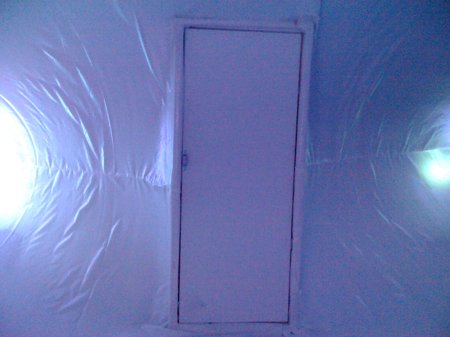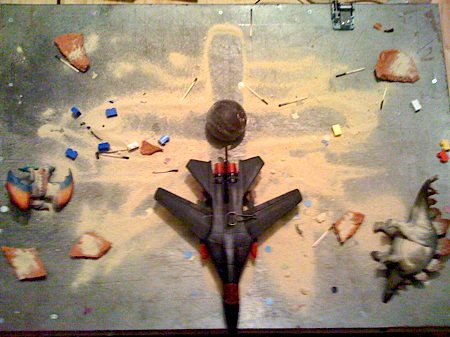More Best Before [KT2009, v]
june 13, 2009.
The special focus on sound in arts and art in sounds during the 10th Maastricht Kunsttour will get a sequel later this year. The project goes by the moniker Best Before, and is co-produced and -curated by the Stichting Intro/In situ, an association that has been promoting and programming contemporary music and sound art in Maastricht and its environs for 25 years.
That makes for one more jubilee...
Intro/In situ hosted an inflatable audiovisual environment by the Feedbacksociety
during this year's Kunsttour, called Feedbackstructures. The inflatable room had been 'blown up' inside
Stichting Intro's space in the Capucijnengang. I took off my shoes, and stepped inside, through a short two-door lock:
you open one door, and close that behind you; then you open the next one,
step into the room, and also
close the second door.
I was all alone.
The room/tent was made out of white tissue, and illuminated from the outside
by flashing lights at the four corners that were stretched out cone-like
and like wormholes seemed to disappear down into nowhere. The room bathed
most of the time in a clinical, cold blue light, which upon entrance made
it look and feel like an abandoned operating theatre. Lights interacted
with sounds, and probably also with the flashes of video that I (but barely)
noticed every now and then. The interaction seemed to be more or less straightforward,
though. Largely due to the 'electric beat' that was going on all the time
after a while I began to feel like the proverbial solitary early bird yearning
for a swing, but arriving at the, say StarTrek, disco way before the real
party is getting on its way. (Watch a
short vimeo of the installation; I guess I should have laid
down and close my eyes.)
[ * ] "Morning runs best_before the city gets
real and best_before your eyes"

What disappointed me was that, the name of the work notwithstanding, there were - maybe except the audio-video interaction - no real time feedback structures at work in the Feedbackstructures. All of the sounds had been designed beforehand. They were just being played back. Given the efforts to construct and set up the inflatable room, and in view of its obvious '(sound) art ambition', not putting it to use as an instrument - for example by having it in some way react to the presence, position and movements of the visitors - felt like a missed opportunity.
[ * ] "Mak'a little grunting noise here, best_before smiling"
I also missed the opportunity to see/hear Paul Devens' surround experiments in Filmhuis Lumière, as well as Leon Spek's Ferrofoon, installed in the tea house in the garden of gallery Marres. And then for some reason I overlooked that in the Cellebroederskapel a soundscape by Paul Coenjaert's was playing. Unfortunate, not only for not hearing Paul's work, but also for missing a chance to re-visit that place. For many years during my youth in Maastricht I frequented the small well-hidden chapel of the former Cellites a lot. My primary school, the Sint Aloysius, was next to it, in the garden of the monastery that both were part of, and all classes regularly went to mass in the chapel. It was there that, early in the swinging sixties, I performed for the very first time: as a singing angel in the yearly school Christmas play ...
[ * ] "Hiss best_before silence"
Paul Coenjaert's composition is one of the contributions to the 2008 edition of Intro/In situ's Auditive Atlas: a 'sound book' of and about the dutch province of Limburg. Over the coming years it will be filled with sound pieces commissioned from artists of Limburgish origin. The sound works should in some way mark a specific location, maybe or maybe not related to the artist's personal history.
Though each piece is meant to be presented at its respective subject-location, you can listen to them, and read their descriptions (in Dutch), starting from the Auditieve Atlas 2008 webpage, which of course includes (an extract of) Paul Coenjaert's Broeders Tocht, located in the Cellebroederskapel.
As I am of Maastricht, hence of Limburgish, origin, the personal historical and local elements for me form a fascinating layer in this first edition of the Atlas. But then I can of course relate much of what I hear directly to my own experiences as a child and as a young adult; and to the many stories that were told then (and now) in my surroundings there. And even though it probably will make parts of it little accessible to a non-Limburgish (or, say, non-Dutch) audience, that of course is what the project is about.
From this point of view the most extreme (as well as the longest) contribution to date is that of Rinus van Alebeek, called Steden van Glas. Part recorded interview at his Heerlen home with his old father, part autobio-historical rant & reflection (at the spot where forty years ago there was a pastoral road leading up the Heksenberg, recorded while today's dense and noisy traffic keeps rushing by), the content of Rinus' fine and highly personal audio-novella will be incomprehensible to non-Dutch speakers. One more in a long series of reasons, I'd say, for those who do not yet master the language, to go and learn it.
The Battle of Lauffeld, from 1747, one of the many bloody battles that over the ages raged in and around Maastricht, is the subject of a multilingual radiophonic narration composed from re-designed battle sounds and the reading of eyewitness and soldiers' stories by Armeno Alberts' and Hans Lemmen's, La Bataille de Lafelt. This is a typical location piece, as it is integrated for playback in a Landmark made by visual artist Hans Lemmen, which can be found at the spot near the village of Lafelt which once was at the heart of the battle.
The pieces in which the narration is not (or much less) language based will be more accessible also for the general listener. Like Kaspar König's Vistrap 4 zonder 2, a swirling collage of music and sounds inspired by the Meuse, in which we are invited to follow the river, its fish and its water, dispersing its and our past and future story in the form of sound all over the world. Water may do so running freely; but the fish, here and there, will need a vistrap (a fish ladder) to proceed.
Also Kim Laugs' Enci '23 is located at a spot near Maastricht that I am very familiar with: the ENCI limestone quarry, a gigantic hole that has been the result of the long during extraction of lime for the production of cement, which - as a by- product - brought to the light a rich variety of fossils from the Cretaceous. Kim's piece is a calmly flowing soundscape, opposing - with both field recordings and electronically generated and/or manipulated sounds - the worlds of the machinery's mechanics at work in the quarry and that of the relative stillness of the surrounding nature.
[ * ] "Nothing best_before space;
Space best_before time"
It is within the limestone and marl
underground of Limburg that Rod
Summers spent his first years away from the british isles. Rod's location of choice for his contribution
to the Auditive Atlas therefore was simply: underground.
Like Paul Coenjaert's also Rod Summers' piece could be heard at location
as part of this year's Kunsttour. He presented it in a series of daily performances
in the cellar of Marres,
in the Capucijnenstraat.
Like in many of the old houses and buildings in Maastricht, the cellar walls
at Marres's are erected in marlstone, and need but a little scratching to
reveal the tiny shells, ammonites
and other small fossils that the stone contains, dating from the area many, many millions
of years ago, when the now-lands of Limburg were covered by an undeep sea.
It is where Rod starts his '150
Million Years of Maastricht's History in Ten Minutes', a sound piece
played back on a vintage reel-to-reel ReVox machine and illustrated in real-time, as
a 'theatre of objects' on a metal table
top under which at both sides a contact microphone is attached.
In little time we pass from dinosaurs along the coast of a shallow subtropical
sea to the K–T
extinction event, and the subsequent domination of mammals. Then, more
or less halfway, language - in the form of contemporary Maastricht
dialect - arrives in the piece with the Beaker
people, makers of the earliest ceramics in the Maastricht region, which
then swiftly enters the current mere tip of the iceberg of its history with
its insertion into the Roman empire, the arrival and long-time reign of
the Roman-Catholic church, throughout the middle ages into the renaissance
and modern times next with, eventually, the advent and rise of industry.
Meanwhile there's war upon war upon war ...
The piece ends with a sound toy playing the melody of Beethoven's Freude, as a symbol of the (temporary?) rise of a - more or less - unified Europe, and we are left facing a table on which in the course of the performance Rod played out 150 million years of Maastricht's history, that now rest there as a tableau, as a still life ... Below's the picture I took of it at the end of one of Rod's performances in Marres on friday May 22nd.

Those who had a chance to be there will not lightly forget the playful and unpretentious spectacle. In other situations I would surely have writhed even at the mere idea of a sound work involving Roman soldiers discussing the crossing of the Meuse with Julius Ceasar... in Maastricht dialect ... and reading their texts with a distinctive amateur theatre group intonation. But backed by the presence and image of an elderly longhaired british artist who with a modest smile used his forefinger to track a short trail across a little heap of marl dust posed on a small metal table top, it became utterly disarming, and a definite highlight of this year's Kunsttour's sound art.
Those in or passing Maastricht this summer should go and see/hear audio work by Rod Summers on show in the Bonnefanten Museum in Maastricht from june 15th until september 27th, as part of the Prospect Park V exhibition, going under the (if you ask me, pretty patronizing) title: "If someone keeps it up that long, there must be something good in it".
[ previous KT2009-entry: Playing the Popular Classics ]
SoundBlog entries about the yearly Kunsttour in Maastricht, the Netherlands:
(june 06, 2013) - A Carcassonne Yodel in Blue [Kunsttour 2013]
(july 03, 2011) - Life is a Color Wire 3 - table version [KT2011]
(june 17, 2010) - Sunny soundy days [KT2010, iii]
(june 10, 2010) - A kitchen table and a game of cards [KT2010, ii]
(may 30, 2010) - Auto*noom en un*titled [KT2010, i]
(june 13, 2009) - More Best Before [KT2009, v]
(june 01, 2009) - Playing The Popular Classics [KT2009, iv]
(may 30, 2009) - "Also high bridges over the river" [KT2009, iii]
(may 28, 2009) - A sound is a sound that sounds [KT2009, ii]
(may 23, 2009) - It feels like summer in the city [KT2009, i]
(june 06, 2008) - Raudio Graffiti: almost live ! [KT2008]
(september 04, 2007) - "leve ookoi!" - iii. ... under scare vogel crow vlucht score down ... [KT2007, iii]
(august 22, 2007) - "leve ookoi!" - ii. OK. Let's Dance... [KT2007, ii]
(august 12, 2007) - "leve ookoi!" - i. Certified Reconditioned [KT2007, i]
(june 04, 2006) - Sonofakunsttoer [KT2006]
tags: Maastricht, Limburg, Kunsttour, sound art
# .314.
smub.it | del.icio.us | Digg it! | reddit | StumbleUpon
comments for More Best Before [KT2009, v] ::
|
Comments are disabled |